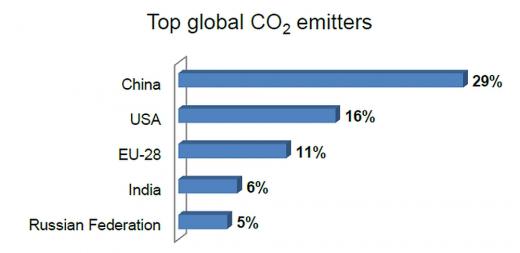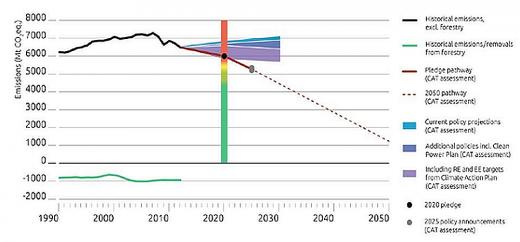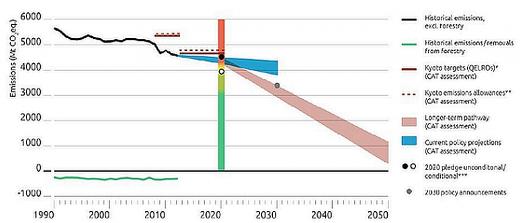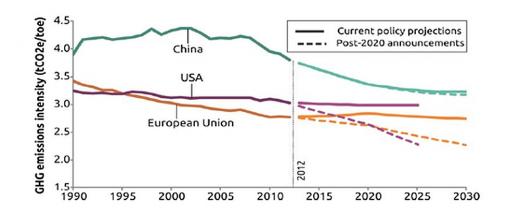Issues:
Sectors:
Keywords:
1. Context of Negotiations
At the United Nations (UN) Climate Change Conference, held in Durban in 2011, governments agreed that they needed to accelerate the reduction of global greenhouse gas emissions and that the existing international regime, the 1992 United Nations Framework Convention on Climate Change (UNFCCC) needed to be strengthened. The UNFCCC itself is a rather vague framework treaty. Parties only later agreed on binding mitigation targets under the 1997 Kyoto Protocol, but only for developed countries and with important actors, like the United States never ratifying the Protocol. Parties thus decided in Durban to launch a negotiation process that would develop a new legal agreement to be adopted in 2015 in Paris and that would be applicable to all Parties1 . The agreement is set to enter into force in 2020. This new negotiation track, named the "Ad-hoc Working Group on the Durban Platform for Enhanced Action" (ADP) is crucial because it also tries to bring on board all Parties, including major emitters of GHG emissions among the developing countries.
At the 19th Conference of Parties (COP 19) in 2013 in Warsaw, Parties agreed that they would initiate or intensify domestic preparation for their so called "intended nationally determined contributions" (INDC) towards that agreement, and to communicate these well before the COP21 in Paris in December 2015. These INDCs set out the mitigation pledges, countries are willing to propose for the period post-2020. This decision can be seen as a big step for developing countries, many of which are for the first time designing mitigation plans or targets, or communicating them at the international level. It also explains why Parties where hesitant to agree on a common format in which these INDCs should be presented, or what type of targets or actions they should contain. It is still contested whether INDCs should cover mitigation only, or also adaptation and finance. Parties were also not able to agree on the type of mitigation contribution to put forward, i.e. economy-wide absolute emission reduction targets, emission-intensity targets, climate actions etc.
By the end of October, 155 Parties (including the European Union member states) have submitted their INDCs, which came as a very positive surprise to many observers2 . This includes the largest emitters of CO2, namely China (29% of global emissions), the United States (16%), the EU (11%), India (6%), the Russian Federation (5%) and Japan (3.8%), accounting for over two thirds of global emissions3 .
China ranks as top global CO2 emitter, outperforming USA
Source: European Commission, A policy framework for climate and energy in the period from 2020 to 2030, 2014.
2. International Landscape
2.1 China
China ranks as the world largest GHG emitter, outperforming USA4 and accounting for almost 30% of global CO2 emissions. This fact is also responsible for the dangerously high levels of air pollution, as seen during the "airpocalypse"5, in the winter of 2014 that hit the capital Beijing and a number of other cities.
China also constitutes one of the world’s most carbon-intensive countries, meaning that it has one of the highest ratios of CO2 emissions to energy use. The combination of China’s large, rapidly growing economy and its carbon intensity implies that its policies will be crucial for global climate change prospects.
Under the 2010 Cancun Agreements, China pledged to reduce its carbon intensity by 40-45% from 2005 levels by 2020. The country’s 12th Five Year Plan, adopted in 2011, includes policies to reduce energy intensity and CO2 intensity by 16% and 17% per unit of GDP, respectively, by 2015, while increasing non-fossil energy to 11,4% of total energy use within the same period6 .
During the UN Climate Change Summit in New York in September 2014, this plan was reiterated by Chinese Vice premier Zhang Gaoli. He also stated that China would ensure its carbon dioxide emissions peak as early as possible. It was added that China would announce post-2020 actions on climate change the soonest possible, including market progress in reducing carbon intensity7.
In November 2014, President Xi Jinping announced China’s political intention to peak its CO2 emissions by 2030 at the latest and increase the share of zero-emission, non-fossil energy sources of the total primary energy supply to at least 20% by then8. These political targets were jointly announced with USA, therefore rendering the two largest global emitters as role models for other countries, so that a global climate agreement can be reached in 2015.
The Chinese INDC document9, which was submitted to the UNFCCC Secretariat on June 30th 2015, largely reflects the commitments made as part of the agreement with the US. Specifically, based on its national circumstances, development stage, sustainable development strategy and international responsibility, China has nationally determined its actions by 2030 as follows:
- To achieve the peaking of carbon dioxide emissions around 2030 and making best efforts to peak early;
- To lower carbon dioxide emissions per unit of GDP by 60% to 65% from the 2005 level;
- To increase the share of non-fossil fuels in primary energy consumption to around 20%;
- To increase the forest stock volume by around 4.5 billion cubic meters on the 2005 level.
China also plans to increase its installed capacity of wind power to 200GW and solar power to around 100 gigawatts (GW), up from 95.81GW and 28GW today, respectively. It will also increase its use of natural gas which is expected to make up more than 10% of its primary energy consumption by 202010.
China is estimated to achieve its 2020 pledge and the objectives stated for 2030, reaching a share of 20% of non-fossil fuels in a manner that is consistent with peaking CO2 emissions by 2030, although the resulting emission level is uncertain11. However, according to the Climate Action Tracker (CAT) INDCs Assessment, China’s submission is rated as "medium with inadequate carbon intensity targets", which if taken literally would only be reached at the expense of important national policies and actions, including in relation to reduced air pollution12.
2.2 USA
In November 2014, US announced its aim to reduce emissions by 26 to 28% below 2005 in 2025 and to make best efforts to reduce by 28%8. This reduction accelerates the emissions reduction rate compared to the US 2020 pledge (17% below 2005 levels by 202013) and is in line with the US long-term target for 2050. The national long-term goal is to reduce emissions by 83% below 2005 by 2050, as stated in the American Clean Energy and Security Act of 2009 (ACES) in the 111th United States Congress14.
As can be seen in Figure 3, US emissions constantly increased until 2007, when the financial crisis occurred. Despite the latest downward trend, the US is unlikely to meet its proposed 2025 goals with the policies currently in place, according to Climate Action Tracker (CAT) assessment, and further actions are needed to achieve significant emissions reductions after 202015.
The additional measures, outlined by the US Administration in "The President’s Climate Action Plan" (CAP)16 in June 2013, can contribute to the achievement of the 2020 pledge. Additionally, the "Clean Power Plan" (CPP)17, announced in June 2014, underlined a plan that aims to reduce emissions from the power sector by 30% below 2005 levels by 2025. Such a reduction would be an important step, but its impact is insufficient to meet the long-term US targets18. High on the agenda of the CAP is the increase of energy efficiency, the doubling of renewable energy sources generation by 2020 and the doubling of energy productivity by 2030, in comparison to 2010 levels. Control of methane emissions, HFCs and LULUCF emissions is also envisaged.
The US government officially submitted its INDC for the Paris Agreement on March 31st 201519. The US intends, as expected, to achieve an economy-wide target of reducing its greenhouse gas emissions by 26% – 28% below 2005 levels in 2025 (making best efforts to reach 28%), and to accomplish this goal with existing regulatory authority, notably Clean Power Plan (CPP) and fuel economy standards for vehicles20. According to the CAT INDCs Assessment, though, US pledges are not yet consistent with limiting warming to below 2°C unless other countries make much deeper reductions and comparably greater effort. Thus, the US submission has been rated as "medium"21.
The current US policy framework demonstrates that the government is creating opportunities to push forward climate change policies, while at the same time it is necessary for the US government to prepare future actions that will lead to further GHG reductions.
2.3 EU-28
The European Council agreed in 2009 to support the long-term objective of reducing EU GHG emissions by 80-95% by 2050, compared to 1990 levels, in the context of necessary reductions according to the IPCC by developed countries as a group22.
To outline the path towards achieving this commitment to a low-carbon future, the EC presented the "Roadmap for moving to a competitive low-carbon economy in 2050". Within this document it is suggested that by 2050, the EU should cut its emissions to 80% below 1990 levels through domestic reductions alone. This goal is considered to be achieved in a cost-effective way by setting intermediate targets for 2030 and 2040, at a 40% and 60% reduction, respectively23.
In October 24, 2014, the European Council approved the 2030 Framework for Climate and Energy. The decision was formed well in advance of the Paris Climate Conference, in order to facilitate the submission of the EU’s offer by early 2015. The objectives to be met by 2030 consisted of24:
- a binding EU target of at least 40% domestic reduction of GHG emissions by 2030, compared to 1990;
- a binding target of at least 27% of renewable energy used at EU level;
- an "indicative" and non-binding target of at least 27% increase of energy efficiency. This target will be further reviewed in 2020, having in mind a level of 30% for 2030;
- the completion of the internal energy market by reaching an electricity interconnection target of 15% between Members States and pushing forward important infrastructure projects.
The EU was the second party, after Switzerland, to submit their INDC to the UNFCCC Secretariat, on March 6th 201525. The EU’s INDC, in line with the European Commission’s Proposal, commits the EU and its Member States to the binding target of an at least 40% domestic reduction in greenhouse gas emissions. It also explicitly excludes from its 40% reduction commitment any contribution from international credits, which is in line with the Commission’s intention to exclude all international credits from the EU Emissions Trading System (ETS). However, due to Member States’ divergent views on how to include Land Use, Land Use Change and Forestry (LULUCF) in the 40% reduction binding target, the EU’s INDC merely states that a "policy on how to include [LULUCF] into the 2030 greenhouse mitigation framework will be established as soon as technical conditions allow and in any case before 2020"26.
According to the CAT assessment, the projections with EU’s current policies continue the past downward trend and put it on a good trajectory toward meeting its 2020 target. However, while emissions continue to decrease, current policies are projected to reduce emissions by 23-35% below 1990 levels by 2030 and therefore, do not - yet - put the EU on a trajectory towards meeting its 2030 targets (40% reduction). EU’s INDC has also been rated as "medium", due to the fact that the overall level of GHG emissions reductions proposed in it is not yet sufficient to fall within the range of approaches for fair and equitable emission reductions for the EU2827.
2.4 India
India, until recently, did not intend to announce any binding targets regarding emissions reduction for the pre or post 2020 era. India’s leaders had opposed to any binding emission cuts and had been in favour of a set of post-2020 arrangements resembling the Kyoto type approach.
As stated in India’s submission for the Ad Hoc Working Group on the Durban Platform for Enhanced Action28: "Under the Kyoto Protocol, developed countries have binding emission cuts in absolute terms which have to be fulfilled at economy wide level and there is a compliance regime for verifying and enforcing the achievement of targets. The responsibilities of developing countries in a post 2020 arrangement will clearly need to be built on the principles of equity and common but differentiated responsibility". It was also added that the post 2020 arrangements must include commitments of developed countries in quantified and specific terms to provide financing and technology enablement and support to developing countries.
However, India has made significant commitments to clean energy and a sustainable economy, including ramping up the existing target of 20 GW of install solar energy by 2022 to a new ambitious solar target of 100 GW, which corresponds to almost half of India’s total electricity generation capacity in 2013. Furthermore, the Indian Finance Minister, Arun Jaitley, made in March 2015 the announcement to double tax on coal production as a way of showing India's commitment to tackling climate change and reaching a solid agreement at the Paris Summit29.
Additionally, in a total change of attitude, India finally announced its long-awaited binding post - 2020 targets on 1 October 2015, by submitting their INDC to the UNFCCC Secretariat30. India intends to lower the emissions intensity of its GDP by 33% to 35% by 2030 below 2005 levels, to increase the share of non-fossil based power generation capacity to 40% of installed electric power capacity by 2030 (equivalent to 26–30% of generation in 2030), and to create an additional (cumulative) carbon sink of 2.5–3 GtCO2e through additional forest and tree cover by 203031. According to the CAT INDCs Assessment, India’s submission is rated as "medium", indicating that India’s climate plans are at the least ambitious end of what would be a fair contribution and not consistent with limiting warming to below 2°C, unless other countries make much deeper reductions and comparably greater effort32.
2.5 Russian Federation
On April 1st 2015, the Russian Federation submitted their INDC33, in which a reduction in its emissions of net greenhouse gases (GHG) by 25% to 30% below the 1990 level by 2030 is proposed34. The goal builds on an earlier target of limiting emissions to 75% of 1990 levels by 2020, but the INDC does not address any adaptation issues35.
Russia’s has formulated two energy targets that refer to different baselines and target years. The first presidential degree, "Concerning some Measures to Increase Energy and Ecological Efficiency of the Russian Economy"36 was adopted in 2008 and includes an energy intensity target of a 40% reduction by 2020 compared to 2007 levels. The second energy intensity target of 44% reduction by 2030 was adopted in 2009. Other capacity-based targets of the country include 3600 MW of wind power, 1520 MW of solar power and 751 of small scale hydro power over the period 2014–202037.
Russia has had high emissions related to the flaring of natural gas. Emissions in Russia dropped in the 1990s, due to the collapse of the Soviet Union, but since then, emissions have increased and experienced only a small impact from the financial crisis. They are expected to continue on the same trend until 20303.
According to the CAT INDCs assessment (which rated the Russian submission "inadequate"), "Russian Federation would allow for the highest emissions from industrial sources of GHG in 2030. After accounting for forestry, the target represents a reduction of only 6% to 11% below 1990 levels excluding LULUCF emissions. Compared to the 2012 emissions level, this represents an increase in emissions excluding LULUCF of 30% to 38%"38.
3. Comparative Assessment
Climate change is a global problem that requires a global solution. There has been a strong trend to reduce GHG emissions and more and more countries propose 2020 emissions reduction goals. By the end of October 2015, 128 INDCs2, reflecting 155 countries (including the European Union Member states) and covering around 87% of global emissions in 2010 (excluding LULUCF) and 88% of global population39, have been submitted to the UNFCCC Secretariat in preparation for the adoption of the Paris Agreement in December 2015.
The two larger emitters of greenhouse gases, China and the US, are both stepping up their actions to reduce emissions and these measures could have a significant impact on global emissions. In particular, according to the CAT Countries assessment40, if China, the US and the European Union (who together comprise around 53% of global emissions) implement their post-2020 plans, they would limit global temperature rise to around 3˚C by 2100 - 0.2˚C-0.4˚C lower than it would have been prior to their announcements. These findings represent significant progress and are more ambitious than previous commitments, but remain insufficient to limit warming below 2˚C.
As can be seen in Figure 5, the implementation of post-2020 policies announced would change the scenery of emissions reduction for both USA and the EU, leading to reduced emissions intensity. USA’s ambitious targets are projected to lead to lower emission intensity than the EU for the period after 2020. China’s results, on the other hand, seem to overlap, indicating that more ambitious post-2020 targets could be adopted, as there is significant room for improvement41.
Furthermore, the Synthesis report on the aggregate effect of the submitted INDCs, released on 30 October 2015 by the UNFCCC secretariat42, indicates that the collective impact of 146 national climate action plans can dramatically slow global emissions into the atmosphere. Another key finding is that their aggregate impact will lead to a fall in per capita emissions over the coming 15 years43.




